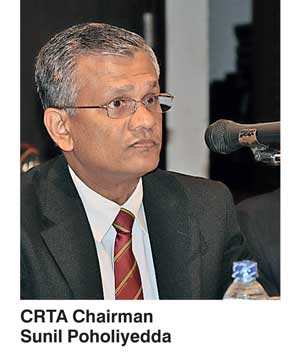Tuesday Apr 22, 2025
Tuesday Apr 22, 2025
Tuesday, 18 July 2017 00:00 - - {{hitsCtrl.values.hits}}
By Charumini de Silva
The Colombo Rubber Traders Association (CRTA) called on the Government to expand the rubber cultivation on a solid plan, cautioning there is a tendency of manufacturers relocating their facilities in countries where rubber is grown.
Addressing the 98th Annual General Meeting of CRTA, Chairman Sunil Poholiyedda emphasised that to successfully execute the Rubber Masterplan which was presented to the Government last year, it was vital to have a fair amount the production to attract or expand the current value addition.
The Rubber Masterplan anticipates to increase production to 300,000 metric tons by the year 2045, while value addition export revenue to improve to $5 billion by 2030.
He cited the alienation of rubber land for urbanisation and other industries as the major factor for the drop in production.
“I am informed by the Planters’ Association that a further 2,500 hectares of rubber land of the Regional Plantation Companies (RPCs) have been identified for acquisition to be used for other industrial purposes. This becomes a major threat to the industry and I appeal to the Plantation Industries Minister to carefully analyse this situation since RPCs production would drastically drop in the future, if it happens,” he stressed.
Poholiyedda further pointed the RPCs have always undertaken the required replanting, which is minimum of 3% and hence there is guaranteed which is not visible in the smallholder.
“I understand that there are many plantation companies interested in expanding rubber cultivation and if alternate additional land is offered to the RPCs, I am confident that most of them who have downstream value addition would accept this offer where land could be offered from non-traditional area. This will allow the entire country to benefit with additional exports of value added natural rubber products,” he added.
The industry called year 2016 was challenging both in terms of production and price. Accordingly, the production reduced to 79 million kilograms in 2016 from 88 million kilograms recorded in 2015, which accounts to an 11% drop. Compared to 2012 production of natural rubber in the country has been almost 50%.
It was pointed that the low production includes reduction in prices of natural rubber due to external reasons as well as the adverse weather conditions which prevailed against the normal weather patterns experienced in the past.
“We also need to consider the change in the weather pattern in the country where the traditional rubber growing areas receive a very high rainfall resulting in less number of days tapping. The rubber growing in these areas would further become unviable. Therefore, diversification is require into crops in certain traditional areas of rubber growing and the cultivation needs to be shifted to the non-traditional areas suitable for rubber cultivation,” he stated.
Poholiyedda was re-elected as the Chairman at the 98th AGM, while Anura Edirisinghe was elected as the Vice Chairman of the Association, which was attended by all stakeholders of the rubber industry which includes planters, traders, manufacturers and exporters of rubber.
The CRTA was formally inaugurated in November 1918, under the mission ‘to be the premier forum for rubber and its main objective is to advance efficient and transparent trade between sellers, producers, buyers, exporters and dealers and to support the expansion and sustainability of the rubber industry in Sri Lanka.
Pix by Lasantha Kumara
Discover Kapruka, the leading online shopping platform in Sri Lanka, where you can conveniently send Gifts and Flowers to your loved ones for any event including Valentine ’s Day. Explore a wide range of popular Shopping Categories on Kapruka, including Toys, Groceries, Electronics, Birthday Cakes, Fruits, Chocolates, Flower Bouquets, Clothing, Watches, Lingerie, Gift Sets and Jewellery. Also if you’re interested in selling with Kapruka, Partner Central by Kapruka is the best solution to start with. Moreover, through Kapruka Global Shop, you can also enjoy the convenience of purchasing products from renowned platforms like Amazon and eBay and have them delivered to Sri Lanka.
Discover Kapruka, the leading online shopping platform in Sri Lanka, where you can conveniently send Gifts and Flowers to your loved ones for any event including Valentine ’s Day. Explore a wide range of popular Shopping Categories on Kapruka, including Toys, Groceries, Electronics, Birthday Cakes, Fruits, Chocolates, Flower Bouquets, Clothing, Watches, Lingerie, Gift Sets and Jewellery. Also if you’re interested in selling with Kapruka, Partner Central by Kapruka is the best solution to start with. Moreover, through Kapruka Global Shop, you can also enjoy the convenience of purchasing products from renowned platforms like Amazon and eBay and have them delivered to Sri Lanka.